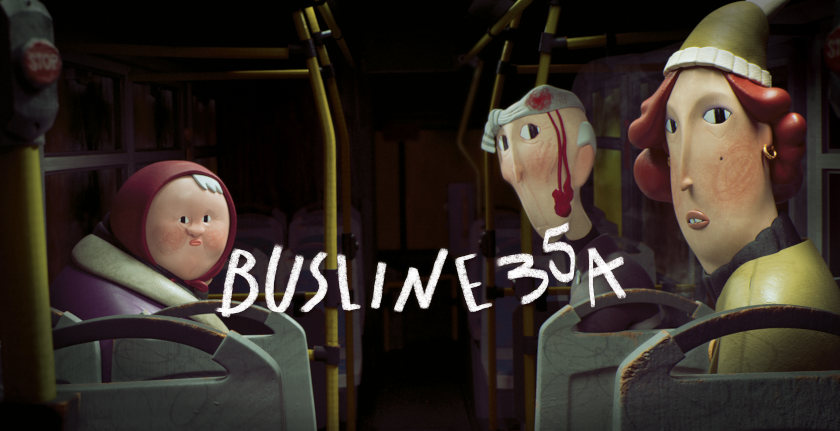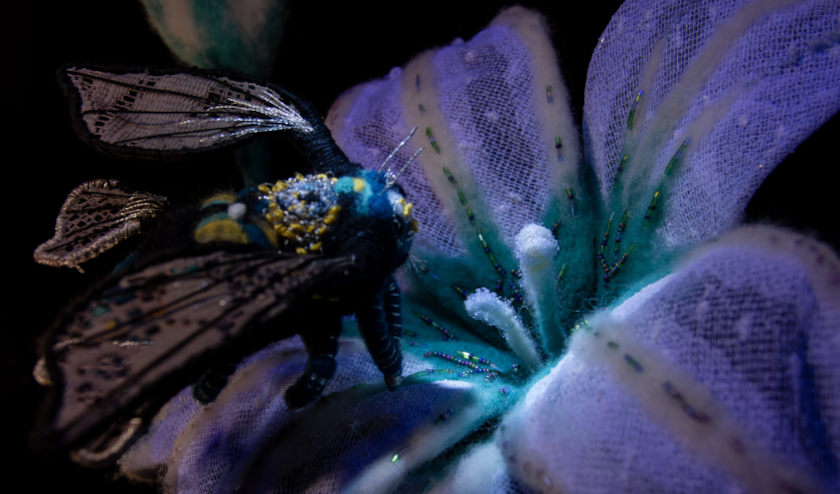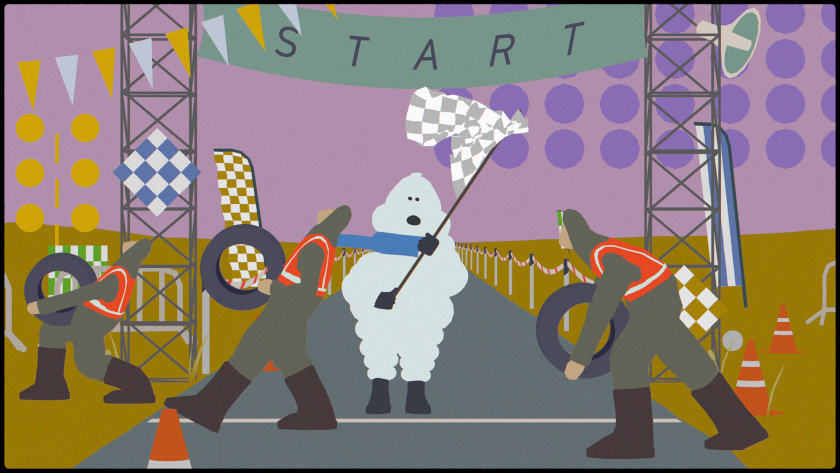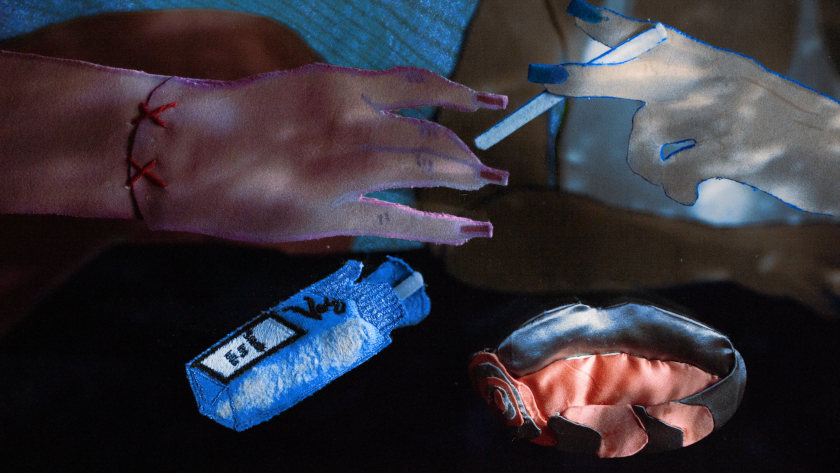BusLine35A by Elena Felici

Italian director Elena Felici has made a highly successful animation short, in which bus passengers have their own secret worries, while at the same time choosing to ignore what's happening in front of their eyes.
Made at Viborg's The Animation Workshop, the 3D computer animation film had a highly successful festival career and is now presented online (exclusively at Zippy Frames).
We asked Elena Felici to give us more details on her work.
ZF: The film looks like it could have been 4 individual stories, yet you knit them together in a fine way. I was wondering if you had a core story, and then the other stories followed through, or ideas and elements came up to you one after the other.
EF: It all happened a bit organically. The initial pitch of the movie was focused on the teenage girl being harassed; the whole story was revolving around her. But I found it a very limiting and unoriginal way of approaching the subject. It felt like I was developing a charity TV commercial and didn’t like it at all. The idea of the three bystanders came halfway into outlining the screenplay, from a deeper study of storytelling principles and an interest in idiosyncratic filmmaking. When I got to know the difference between the camera’s and the narrative's point of view through a Podcast called Draft Zero, it opened the gate to so many possibilities: I was going to give the story three different narrative points of view. Once set on splitting the animated short into multiple chapters, it all started coming together. It was just a matter of finding their right order and intriguing, little anecdotes about the bus passengers.
ZF: You state your film is inspired by Roy Andersson and Don Hertzfeldt. Can you explain what you find fascinating in these authors and how did you try to integrate those influences into your film?
EF: In my opinion, Andersson and Hertzfeldt are two very different authors, but have a raw and dark sense of comedy in common. They both present the theme of the human condition through awkwardness and detachment. My main objective was to do the exact same thing. There is a unique dualism between the seriousness of the harassment and the ineptitude of its witnesses; it creates this contrast in which the viewer is tangled and doesn’t know whether to laugh or despair. I believe Andersson’s and Hertzfeldt’s play with the same dualism, pushing these two extremes so far we can’t help but look within ourselves. And even with childish and minimalist designs, they deliver such heavy subject matter. They’re incredibly inspiring.
ZF:I really liked the narrating voice, it gives another personality to what's happening. Did you consider at any point including dialogues for the three passengers or perhaps you wanted this to be only an inner process in the passengers' own minds?
EF: Conversations between the three passengers were never considered. In the early stages of the screenplay, the bus driver played a role in the story but even then, there wasn’t any diegetic dialogue involved. In my experience, when on public transport (besides airplanes maybe), we tend to keep ourselves in our private spaces. We are all locked into a moving box, so close to one another and yet so detached at the same time. The narrative voice is something different, it’s a tool aiming to distract the viewers, the same way we tend to create justificative narratives in our head when torn between helping or not helping. We have entire dialogues within ourselves just to avoid accepting something is off and we should intervene.
Watch BusLine35A:
ZF: Your film is in 3D and obviously takes a lot of other hands to complete it. Can you tell us a bit more about your aesthetic choices here and the way you collaborated in animation etc? Did you make yourself a previs and other people animated, for instance?
EC: The art direction of the movie is something I struggled with. I don’t personally see myself as a strong visual designer and had no clear idea which way to go, contrary to developing the story. Initially, we aimed for an expressionistic style, focusing on rough brush strokes a la Alberto Mielgo, and sharp character designs inspired by Egon Schiele. On its own, without putting it in perspective with the story and narrative voice, it looked fantastic. But then, juxtaposing a preview of the narrative voice together with the visual designs made us realize we were aiming at the wrong target. Schiele's style made the short feel creepy rather than humoristic and childish. Furthermore, having too complex and packed visuals was distracting the audience’s attention from the actual storyline. We needed something light, less gloomy, a design that made the audience giggle at first sight. A caricature and simplistic style is what we went for, adding elements that made the characters feel pathetic and inept. On the other hand, like our main theme, the design kept certain elements of realism, it was grounded. The stop-motion look and hand-crafted textures with scanned crayons really conveyed the look we were looking for.
Around ten artists worked on the animated short, six CG Artists and four Animators, me included. We used Autodesk Maya for the 3D pipeline. As a director, it was my responsibility to deliver a strong screenplay and master edit (animatic, previs and final). Those were the two things I usually focused on before and after work hours when I was alone and had the mental space to dive deep into them. From 9 to 17, our team worked on making sure the look and motion of our short were on point. Like any other linear production, we started with visual design, storyboarding and RnD. We ended with compositing and color grading. Yes, I made the whole previz myself. Then joined the animation team and delivered a few shots on my side.



Our team was composed of three Animators only, therefore I felt it was necessary to support them as much as I could. The Animation pipeline was straightforward: based on the animatic, we were shooting live-action references and then diving straight into Maya and to a first blocking pass (just key poses). After Erika G. Strada’s approval (Anim Lead), we would move on to splining out and polishing the shot. Reviews were possible through SyncSketch, a free online tool where you can draw over and give precise feedback on animations. On the Art Direction’s side, the procedure was similar: CG Artists were delivering their renders to Aleks and Mia (Art Directors), received feedback, and kept on working until the asset reached the final state. For Production Management we used Shotgun, an industry-standard tool to keep track of your published assets.
ZF: I really liked that your shot composition: it always has in the background the harassing man and the young lady, even though the characters speak about their own petty issues. Was that intentional?
EF: Yes, that was intentional. The harassment had to be a constant and increasing presence throughout the short. The pattern is:
1. Old Lady, where the backseat scenario is barely visible, covered by her selfishness and self-centeredness
2. Old Man, where we notice a first reaction to the harassment, more prominent in the frame
3. Middle-Aged Woman, where the camera pattern breaks, not sticking to the passenger’s frontal shot anymore, but seeing what was happening behind the scenes, while we were focusing on our inner thoughts, careless of our surroundings.
With each new chapter, we move closer to the backseat scenario and start understanding what the actual core of the story is.
ZF: Did you find any difficulties in the character design of the 5 characters or it was business as usual?
(Aleksandar Komit, co-Art Director)
AK: Yeah, it was difficult. The Old Man had to look fragile, the Old Lady cute and round like meatballs, and the Middle-Aged Woman panicky and nervous. All of these elements were defined through trial and error, sketching the characters repeatedly and showing them to Elena until they fit how she imagined them. We tried keeping our hands and drawings loose, so they seemed rough and childish even in the linework. We literally drew 40+ faces on a sheet to decide the right facial expressions for each character, we would do slight alternations on our drawings and shift the proportions around. The same approach was applied to clothes design too. Then, if you think about it, the three bystanders are defined by the three primary shapes: square, triangle, and circle. The Old Man is a square, very elongated to look weaker, the Old Lady a circle, and the Middle-Aged Woman a triangle. We also assigned one color to each passenger for formalistic reasons, it helped to divide them into three different chapters.
All these little details were added to give flavor and make the characters feel like they belonged to their storyline. The biggest challenge was translating the sketches into 3D models, most of the time they would lose their strong silhouette, so I and Mia had to sketch over all of them in the end, making the shapes extremely polished. We wanted the CG characters to have a nice silhouette at every angle we were going to see them in the movie, therefore we had to make numerous adjustments until that was achieved. I had to overpaint the 3D a lot to make sure the CG Artists knew how to sculpt them. Lastly, for the textures, we scanned pencil scribbles on paper. Then create stamps to use as brushes during the shading process in Substance Painter. Same for the eyes, inspired by the anime Azumanga Daioh, and cheeks.”
ZF: This is a TAW animation film, and you collaborated with many well-known professionals. Were you intimidated and did you have any commitments schedule-wise?
EF: Not intimidated, since all the instructors at TAW are incredibly humble and kind. But I found it difficult to draw a line between following their feedback and my own artistic voice, at our post-mortem meeting my teammates criticized a lack of decision-making on the director’s side. Each artist has their own taste and navigating between them I often got lost, constantly changing my mind on the visual style based on the opinions of our supervisors. Thus said, in struggle there is growth and this experience helped me get in touch with my own sense of taste and beauty.
ZF: Is vulnerability and apathy a topic you'd like to explore in your next films, or it stops here?
EF: Good point. It is interesting how vulnerability and apathy are the two themes all my pitches deal with. I am in the process of developing a new screenplay revolving around the human condition. Insecurity follows a lack of self-care; we can’t bear ourselves and therefore we would rather depend on others, to the point where our own sense of self becomes the former. We are not us without them.But what happens when we are forced to leave them behind? My next animated project will be a character’s journey toward independence and self-care. I’ll leave you like that, with a generic yet specific punchline, yet again dealing with the duality of the opposite.

Film Review (Vassilis Kroustallis):
This is a beguiling film; its smooth voice-over and immediately recognizable characters (with all their worries in 2D animation) disguise the overall ordinary cruelty that most of the passengers exhibit. 'BusLine35A' is a film that moves between noir and thriller, without succumbing to easy conventions, but penetrating into the soul of its handily designed 3D characters -as if to tell us that simplicity is always wrong. It has pertinence, relevance, and a succinct sense of situations exploding like a time bomb. Stays in your mind long after viewing.
About Elena Felici:
She is a previs artist and digital filmmaker based in Viborg, DK. Studied at The Animation Workshop (Viborg, Denmark). Her film 'BusLine35A' is her first animation short.
CREDITS:
BusLine35 A by Elena Felici
Production: The Animation Workshop
Distribution: MIYU Distribution








